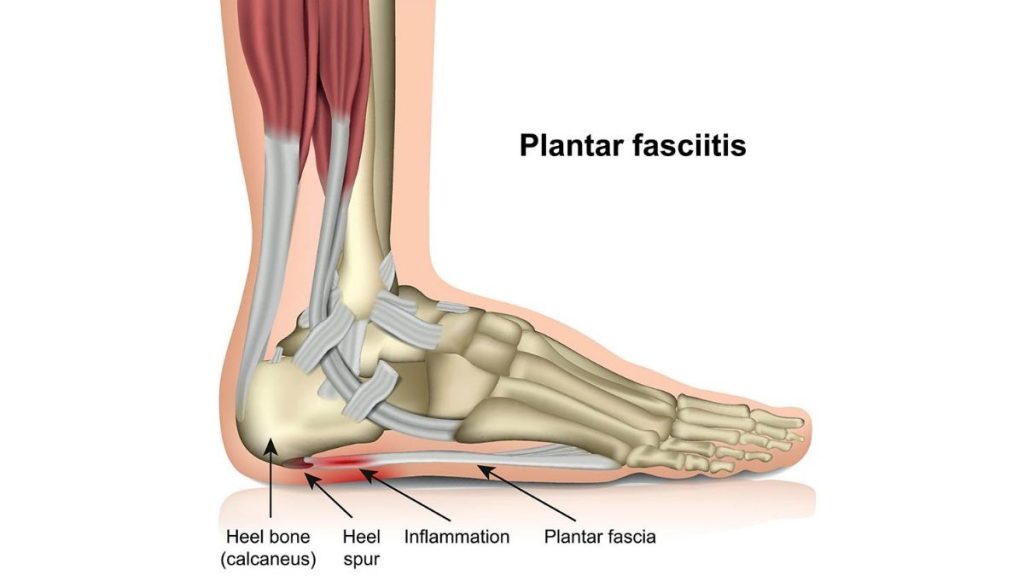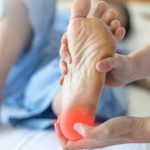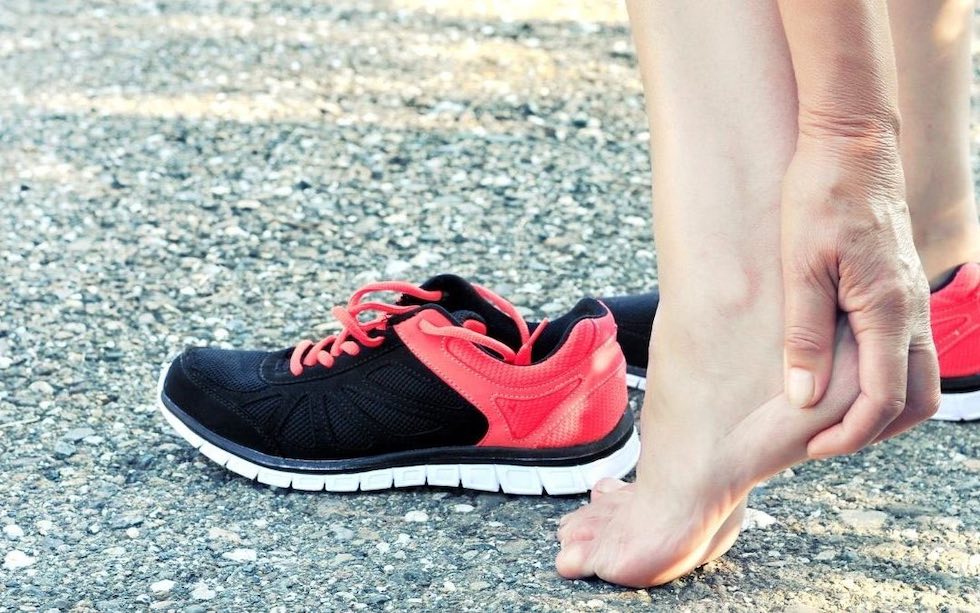Plantar Fasciopathy (PF), formerly called plantar fasciitis a common condition that appears in our clinic. It involves pain and structural changes that occur at the insertion of the plantar fascia into the heel bone.
PF has an estimated prevalence of 3.6-7% and is the most common cause of inferior heel pain (Caratun, 2018). This condition is commonly seen in people who quickly increase their load, whether this is an increase in the amount of training, change in the type of training, a change in footwear, or something as simple as a change in work duties requiring more standing time or time spent on their feet.
In runners, PF accounts for 8% of all running injuries (Caratun, 2019) and the plantar fascia is the most common injury associated with abnormal foot mechanics in runners (Lareau et al 2014). Given the increased number of people who have begun running and outdoor activity during COVID-19 isolation, we thought it would be a great time to highlight this issue, as early intervention helps to prevent the advancement of degenerative changes.
Anatomy
The plantar fascia is a thick band of fascia which runs from the medial aspect of the calcaneus and inserts into the metatarsals. It is a major transmitter of force between the hind foot and fore foot to allow for push off in gait and running. Plantar fasciopathy is typically an overuse type injury that occurs at the insertion into the heel bone and is characterised by collagen fibre disorganisation and increased vascularity. Prolonged untreated PF can lead to spurring at the tendon’s attachment site and degenerative tearing through the fascia. The reason the condition is now known as Plantar Fasciopathy is that Plantar Fasciitis refers to inflammation whereas what is usually seen is tissue degradation rather than an inflammatory condition.

Examination
On examination, patients typically present with local foot pain at the base of the calcaneus (heel bone) or over its medial aspect, with symptoms usually worse in the morning, especially the first few steps. Plantar fasciopathy usually presents with gradual onset of pain and is usually felt on the bottom and middle of the heel.
Although it is commonly experienced in the morning when getting out of bed, symptoms are also commonly noticed after having been stationary for some time. It typically decreases with activity and then returns post-activity. As the condition becomes more severe, pain may be present even while standing and worsen with activity, causing the sufferer to limp. Plantar fasciopathy is commonly described as a burning sensation at the bottom of the foot and may be settled by icing the bottom of the foot.
Patients will have pain on assessment of functional plantar flexion (pointing the toes), big toe extension, and tenderness over the origin of the plantar fascia. This can be located medially or inferiorly to the calcaneus. They may also have restricted range of motion through the ankle or first toe.
Plantar fasciopathy can be diagnosed by a physiotherapist through a thorough subjective history, clinical testing, and special tests. A physiotherapist is additionally able to outline contributing factors leading to a PF. Imaging may be useful to exclude other pathology which may present similarly:
- Calcaneal fat pad impingement
- Insertional Achilles tendinopathy
- Bursitis
- Morton’s neuroma
The subjective assessment in the management of this condition is vital in understanding causative factors such as rapid spikes in training loads, a change in footwear, effects of previous injury or prolonged standing.
Although clinical examination of the foot and ankle is important, examination of the whole kinetic chain is imperative also to understand maladaptive movement patterns which can lead to secondary injuries. The knee, hip and pelvis should all be assessed in patients with PF, as should functional testing relating to a patient’s occupation, sport or goals.

Risk Factors
- Running training & running bare foot (Sinclair 2015 & Taunton et.al 2002).
- Ages 45-60 are at a higher risk (Monteagudo, 2018)
- Reduced dorsiflexion (movement of toes back towards the head) range of motion, lack of strength into plantarflexion and toe flexion
- Pregnancy, overweight & inactivity (Orchard, 2012 & KDB Van Leeuwen, 2016)
- Prolonged standing (Cole et.al 2005)
- High training load (hours + days) / spike in training loads
- Poor biomechanics (e.g. Varus/bowed knees, poor gluteal/pelvic stability)
- Change in footwear (e.g. spiked athletic shoes)
Treatment
Upon initial diagnosis of a plantar fasciopathy, load management is imperative in early symptom management and long-term recovery. This means adjusting the patients’ training schedule or workload to offload the plantar fascia. This can be done by adjusting the amount or type of exercise, a reduction in the time spent on their feet or a simple change in footwear. The education provided by our physiotherapists around load management is equally as important as the exercises prescribed and manual therapy techniques used. In severe cases, or when a tear is present a CAM boot may be used to help offload the foot, and cortisone injections may also be prescribed by doctors as an adjunct to help settle symptoms.
As part of our routine treatment and management at Five Dock Physiotherapy & Sports Injury Centre, our physiotherapists use the most current evidence-based practice in the management of PF in order to achieve patient goals and get good outcomes.
Strength training and improving endurance of the intrinsic foot muscles and calf muscles, as well as working on the biomechanics and control of the foot-knee-hip complex, is shown to result in positive outcomes for the patient. Depending on how symptomatic the patient is, their normal walking pattern may be altered by pain which can lead to secondary injuries such as knee, hip or back pain, and in some instances poor biomechanics or previous injury may be a precursor to injury, increasing the load and overstressing the plantar fascia. As a result, strengthening and improving muscle activation patterns in these areas is imperative for a favourable outcome.

What does the Evidence say?
McPoil et.al 2008 found that a stretching and strengthening program in conjunction with shoe inserts proved beneficial in the management of PF. Lee et. al, 2019 suggest the importance of including hip strengthening including gluteal and pelvic stability exercises in the holistic management of PF.
If shoe inserts or custom orthotics are required, our physiotherapists can refer to a podiatrist, and we are fortunate to share our clinic space with a Podiatry Business (Footology Podiatry) who can assess and assist with orthotics as needed.
Currently, there has been extensive evidence suggesting the importance of high load strengthening in improving outcomes of patients with plantar fasciopathy. Caratun et al (2018), used a 3-month strengthening program, stressing the plantar fascia through progressive concentric and eccentric resistance exercises (using the windlass mechanism with Achilles tendon loading – the windlass mechanism is a mechanical model that describes the manner which plantar fascia supports the foot during weight-bearing activities and provides information regarding the biomechanical stresses placed on plantar fascia). Strength programs were found to have an improvement in foot function, with reduced disability and pain three months following the strengthening program (Rathleff et al, 2014 & Caratun et al, 2018).
Some people recommend the addition of a tension night splint to rehabilitation however a study by Wheeler et. al (2017) reports no significant additional benefits in either pain, function or flexibility with their use. Shockwave is also increasingly being used with some studies suggesting benefits however its long term efficacy remains unknown.
Overall, when diagnosed and managed correctly, including the understanding of the causative factors such as load, footwear, biomechanics and the impact of previous injury, and then rehabilitated with the right exercise program and load management, Plantar Fasciopathy is a condition that can respond extremely well to physiotherapy.
Are you troubled by Plantar fascia pain?
GET AN ASSESSMENT & TREATMENT WITH OUR AMAZING TEAM OF PHYSIO’S.

- Get crystal clear and an Accurate Diagnosis!
- Find out the most important steps for you to get pain free and back to life fast!
- Understand how to manage your activities without suffering the consequences of further pain & injury
- Find out the simple yet essential exercises that can give you relief and speed up your recovery
- Leave the session with the confidence of knowing exactly what to do to get symptom free and get back to life, sport, activity and all the things that you love.

